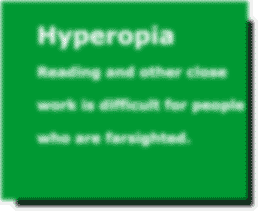Vision Conditions

Normal vision
With normal vision everything you see is clear and in focus, you might hear this called 20/20 vision.
That means that you can see clearly at 20 feet what most people with normal vision can see.

Nearsighted (Myopia)
If you have myopia you can clearly see close objects, but distant objects are blurry. Myopia is caused by the eyeball being too long. Myopia occurs in different degrees from minimal to extreme. The more myopic you are the blurrier your vision is at a distance and objects will have to be closer to you so you can see them clearly.
Nearsightedness occurs when the eye has too much “plus power” and the eye focuses the light in front of the retina.
Nearsighted people’s vision is blurry at a distance. They might see something like this picture when they look at things far away.

Farsighted (Hyperopia)
If you have hyperopia, you can see distant objects clearly, but close ones are blurry.
Hyperopia occurs when the eyeball is too short for the light rays to focus clearly on the retina.
Farsighted people’s vision is blurry close up.
They might see something like this picture when they try to read or do close-up work.
Astigmatism
People with an astigmatism don’t see clearly at any distance.
If you have an astigmatism, the surface of the eye (cornea) is not perfectly round, rather it is more oval and doesn’t allow the eye to focus clearly. The cornea is very important in helping the eye focus light rays on the retina. Astigmatism rarely occurs alone. It is usually accompanies myopia or hyperopia.
Presbyopia
If you have presbyopia, you have the loss of the ability to focus up close that occurs as you age. Most people are between 40 and 50 years when they realize for the first time that they can’t read objects close to them. The letters of the phonebook are “too small” or you have to hold the newspaper farther away from your eye to see it clearly. At the same time your ability to focus on objects that are far way remains normal.
Color Blindness
Most of us share a common color vision sensory experience. Some people, however, have a color vision deficiency, which means their perception of colors is different from what most of us see. The most severe forms of these deficiencies are referred to as color blindness. People with color blindness aren’t aware of differences among colors that are obvious to the rest of us. People who don’t have the more severe types of color blindness may not even be aware of their condition unless they’re tested in a clinic or laboratory. Read more
Information courtesy of the National Eye Institute, National Institutes of Health.
|










